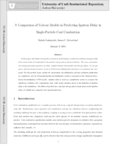Filters: School Or College: "College of Engineering" Department: "Chemical Engineering" Collection: "ir_uspace"
| Creator | Title | Description | Subject | Date | ||
|---|---|---|---|---|---|---|
| 26 |
 |
Rashid, Khalid; Powell, Kody | Dynamic simulation, control, and design of a novel solar thermal hybrid power plant | Solar power is among the promising technologies leading towards cleaner fuel. However, there are still technological challenges regarding the reliability of power generation due to its intermittency. This work demonstrates the synergies that exist in integrated hybrid systems, where a dispatchable f... | Solar energy--Research; Solar thermal energy--Research; Solar power plants--Research | 2017 |
| 27 |
 |
Sutherland, James Clayton | Advanced regression methods for combustion modelling using principal components | Modelling the physics of combustion remains a challenge due to a large range of temporal and physical scales which are important in these systems. Detailed chemical kinetic mechanisms are used to describe the chemistry involved in the combustion process yielding highly coupled partial differential e... | 2014-01-01 | |
| 28 |
 |
Whitty, Kevin J. | A pulse-width modulation controlled wire-mesh heater apparatus for investigation of solid fuel pyrolysis | A novel wire mesh heater apparatus has been developed to study the devolatilization of solid fuels under pressurized conditions at well-controlled heating rates on the order of 1000 K/s. The apparatus combines direct current and pulse-width modulation with a fast-acting and high current-capacity re... | 2012-01-01 | |
| 29 |
 |
Sutherland, James Clayton | A comparison of various models in predicting ignition delay in single-particle coal combustion | In this paper, individual coal particle combustion under laminar conditions is simulated using models with various levels of complexity for the particle and gas phase chemical kinetics. The mass, momentum and energy governing equations are fully coupled between the particle and the gas phase. In the... | 2014-01-01 | |
| 30 |
 |
Smith, Philip J. | State space sensitivity to a prescribed probability density function shape in coal combustion systems: joint β-PDF versus clipped Gaussian PDF | The turbulent transport of three coal off-gas mixture fractions is coupled to a prescribed joint //-probability- density-function (//-PDF) mixing model. This physical transport and subgrid joint //-PDF mixing model is used to explore the incorporation of coal off-gas compositional disparities betwe... | Off-gas stream; β-PDF; Char oxidation | 2000 |
| 31 |
 |
Pershing, David W. | Control of NOx and particulate emissions from spreader-stokers fired with hogged wood | The formation and emission of nitrogen oxides and particulate carry-over were studied from spreader-stoker combustion of hogged Douglas-fir, with a focus on optimizing the combustion conditions in each of the two distinct combustion zones, the bed phase and the suspension phase local oxygen availabi... | Chemical analysis; Combustion; Emission; Engineering; Environmental control; Fuels; Nitrogen compounds; Particulates; NOx; Hogged wood | 1987 |
| 32 |
 |
Pershing, David W.; Wendt, Jost O. L. | Pulverized coal combustion: the influence of flame temperature and coal composition on thermal and fuel NOx | A laboratory combustor was used to investigate the factors that influence the conversion of fuel nitrogen in coal during coal combustion. Fuel NO was isolated by experimentation utilizing Argon / Oxygen / Carbon Dioxide mixtures as the oxidant, and care was taken to compare cases with air at matche... | Fuel nitrogen; Flame temperature; Coal composition | 1977 |
| 33 |
 |
Pershing, David W. | Formation and control of NO emissions from coal-fired spreader-stoker boilers | Stoker coal-fired furnaces are significant in terms of coal consumption and environmental impact; however, they have received little research attention. This paper describes the results of a study on the formation and control of nitrogen oxides in coal-fired spreader-stoker systems. Three scales of... | Stoker coal-fired furnaces | 1983 |
| 34 |
 |
Eddings, Eric G. | NOx emissions from intermediate-temperature combustion of steel-industry by-product gases | A study of NOx emissions from the combustion of coke-oven gas and blast-furnace gas (steel industry by-product gases) was undertaken using detailed kinetic modeling to elucidate the pathways for NOx formation. The study was performed at the intermediate temperatures (1200-1400K) and 1 atm, which rep... | 2004 | |
| 35 |
 |
Eddings, Eric G.; Sarofim, Adel F.; Pershing, David W. | Production of nitrogen oxide during char oxidation at pulverized coal combustion conditions | More stringent regulations for NOx control in pulverized coal combustors have made the scientific community focus on sources of emissions that were traditionally considered less relevant to the overall NOx production. The oxidation to NO of the nitrogen that is organically bound to the char is one o... | 2001 | |
| 36 |
 |
Eddings, Eric | Modified CPD Model for Coal Devolatilization at UCTT Conditions | To study coal pyrolysis behavior at underground coal thermal treatment (UCTT) conditions, a modified CPD (M-CPD) model was developed and evaluated using two scales of experiments as well as two different coals, Utah Sufco and Illinois #6. Compared with the original CPD model, three major aspects wer... | Coal; pyrolysis; modeling; underground heating | 2019 |
| 37 |
 |
Sarofim, Adel F.; Eddings, Eric G. | Muiltifunctional fuel additives for reduced jet particlate emissions | Using Government drawings, specifications, or other data included in this document for any purpose other than Government procurement does not in any way obligate the U.S. Government. The fact that the Government formulated or supplied the drawings, specifications, or other data does not license the ... | 2006 | |
| 38 |
 |
Pershing, David W. | Influence of fuel composition and flame temperature on the formation of thermal and fuel NOx in residual oil flames | A 900 kw model package boiler and a 20 kw laboratory tunnel furnace were used to study fuel and thermal NO, formation during heavy oil combustion. Package boiler results indicated that atomizer design, spray/ flow field interactions, and fuel composition were significant, dependent parameters. These... | Residual oil flames | 1979 |
| 39 |
 |
Pershing, David W.; Slaughter, David Michael | Parameters influencing the evolution and oxidation of sulfur in suspension phase coal combustion | Stoker coal-fired boiler furnaces are significant in terms of coal consumption and environmental impact; however, they have received relatively little research attention. This paper describes the results of a two-year study on the formation of sulfur oxides in the suspension phase of a coal-fired s... | Stoker coal-fired furnaces | 1983 |
| 40 |
 |
Sutherland, James Clayton | A filter-independent model identification technique for turbulent combustion modeling | In this paper, we address a method to reduce the number of species equations that must be solved via application of Principal Component Analysis (PCA). This technique provides a robust methodology to reduce the number of species equations by identifying correlations in state-space and defining new v... | 2012-01-01 | |
| 41 |
 |
Lighty, Joann; Silcox, Geoffrey | Fundamentals of mercury oxidation in flue gas | This report was prepared as an account of work sponsored by an agency of the United States Government. Neither the United States Government nor any agency thereof, nor any of their employees, makes any warranty, express or implied, or assumes any legal liability or responsibility for the accuracy, ... | 2006 | |
| 42 |
 |
Sutherland, James Clayton; Kerstein, Alan R. | A unified approach to the various formulations of the one-dimensional-turbulence model | The One-Dimensional Turbulence (ODT) model has been successfully applied as a stand-alone model for predicting turbulence statistics in both nonreacting and reacting flows. There are several formulations of the model in the literature, and most of the variable-density formulations do not clearly dis... | 2010 | |
| 43 |
 |
Eddings, Eric G.; Sarofim, Adel F. | Olefin chemistry in a premixed n-heptane flame | Three different n-heptane mechanisms were used to simulate a fuel-rich normal heptane premixed flame in order to identify major reaction pathways for olefin formation and consumption and areas of uncertainties of these reactions. Olefins are formed mainly via ?-scission and hydrogen abstraction, and... | Heptane mechanism; N-heptane; Olefin formation; Olefin consumption; Alkyl radicals | 2007 |
| 44 |
 |
Sarofim, Adel F.; Pugmire, Ronald J. | 13C NMR analysis of soot produced from model compounds and a coal | Soot samples, including the associated organics, produced from an Illinois No. 6 coal (five samples) and two model compounds, biphenyl (three samples) and pyrene (two samples), have been studied by 13C NMR methods. The coal soot data served as a guide to selection of the temperature range that would... | 13C NMR; Biphenyl; Aromatic cluster size | 2001 |
| 45 |
 |
Eddings, Eric G.; Sarofim, Adel F. | Journey from n-heptane to liquid transportation fuels. 1. The role of the allylic radicals and its related species in aromatic precursor chemistry | The Utah normal heptane mechanism compiled from submechanisms in the literature was extended into a detailed normal decane combustion mechanism, which is a subset of the Utah surrogate mechanisms. Few species have greater impact on the concentrations of other species than the allyl radical CH2CHCH2.... | Utah Surrogate Mechanisms; Heptane mechanism; Decane combustion mechanism; Allyl radical; Aromatic precursors | 2008 |
| 46 |
 |
Eddings, Eric G.; Sarofim, Adel F. | Pollutant emissions from gasoline combustion. 1. Dependence on fuel structural functionalities | To study the formation of air pollutants and soot precursors (e.g., acetylene, 1,3-butadiene, benzene, and higher aromatics) from aliphatic and aromatic fractions of gasoline fuels, the Utah Surrogate Mechanisms is extended to include submechanisms of gasoline surrogate compounds using a set of mech... | Pollutant emissions; Soot precursors; Gasoline surrogate compounds; Utah Surrogate Mechanisms | 2008 |
| 47 |
 |
Eddings, Eric G.; Sarofim, Adel F. | Mechanism reduction and generation using analysis of major fuel consumption pathways for n-heptane in premixed and diffusion flames | Reaction pathway analyses were conducted for three mechanisms (designated as the Pitsch, Utah, and Lawrence Livermore National Lab) for a normal heptane premixed flame (? = 1.9) and a normal heptane opposed diffusion flame, in order to identify the relative importance of the major fuel consumption p... | Pitsch mechanism; Utah mechanism; Lawrence Livermore National Lab mechanism; Mechanism reduction; Heptane premixed flame | 2007 |
| 48 |
 |
Sarofim, Adel F.; Truong, Thanh | Kinetics of hydrogen abstraction reactions from polycyclic aromatic hydrocarbons by H atoms | An application of the Reaction Class Transition State Theory/Linear Energy Relationship (RC-TST/LER) is presented for the evaluation of the thermal rate constants of hydrogen abstraction reactions by H atoms from Polycyclic Aromatic Hydrocarbons (PAH). Two classes of reactions have been considered, ... | Reaction Class Transition State Theory; Linear Energy Relationship; Hydrogen abstraction reactions | 2004 |
| 49 |
 |
Eddings, Eric G. | Joint NSF-NSFC Workshop on Combustion Related to Sustainable Energy | A workshop on Combustion Related to Sustainable Energy was held in Hangzhou, China on March 10-12, 2014. The workshop was jointly sponsored by the U.S. National Science Foundation (NSF) and by the National Science Foundation of China (NSFC). The purpose of the workshop was to bring together a limite... | Combustion, sustainable energy, research needs, climate change, renewable fuel, efficiency, Workshop China | 2016 |
| 50 |
 |
Eddings, Eric G.; Sarofim, Adel F. | Thermal behavior of a high-energy material immersed in a fire | One of the uncertainties in the calculations of time-to-explosion for containers of high-energy materials immersed in fires is that of the thermal boundary at the container-explosive interface. Understanding this interface is critical in evaluating risks, safety issues and prevention mechanisms. In ... | 2004 |
